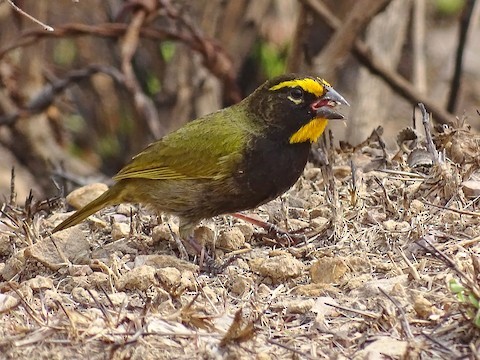The Yellow-Faced Grassquit’s appearance is nothing short of captivating. The male sports a black forehead, which extends to the sides of his face, chest, and throat. His olive green crown, back, wing coverts, and tails create a harmonious blend with the striking yellow “eyebrows” that grace his face. Dusky flight feathers edged with olive green complete his ensemble. Underneath, he is adorned in shades of gray olive, completing a striking contrast that catches the eye.
The female, slightly smaller than her male counterpart, carries a more subtle charm. Her plumage is characterized by a dull olive green above and a paler gray below. She may have faint dark smudges on her chest, adding to her understated beauty. The patterns on her face showcase a muted yellow, while her lower beak is adorned in dark horn-colored hues.
Endemic to the Central American tropics and surrounding regions, the Yellow-Faced Grassquit finds its home in lowland areas and foothills, thriving at altitudes of up to 7,500 feet (2,300 meters). These birds favor semi-open habitats, such as weedy fields, roadsides, and low-scrubbed regions, where they can exhibit their grace and charm.

The Yellow-Faced Grassquit’s diet is as varied as its habitat. Their primary preference lies in grass seeds, a staple of their diet. However, when these seeds are scarce, they readily turn to other seeds, berries, and even insects. Their dining repertoire extends to nectar, which they extract from flowers. Insects are either gleaned from foliage or collected from the ground, showcasing their versatility as foragers.
The breeding season for Yellow-Faced Grassquits spans through the summer, with the exception of February to April. During this time, they build dome-shaped nests in loose colonies using grass, straw, and weed stems. These nests are strategically placed in tussocks or low bushes, offering protection for the entrance located around 1 foot from the ground. Clutches of 2 to 3 eggs, marked with brown speckles, are incubated by the female for 12 to 14 days. Parental care extends to both genders, with both parents contributing regurgitated seeds to nourish the young.

Remarkably common with a wide distribution, the Yellow-Faced Grassquit is classified as of “Least Concern” on the IUCN Red List. This status underscores the species’ adaptability and resilience within its ecosystem. Nevertheless, ongoing efforts to safeguard its habitat are vital for ensuring the continued presence of this elegant bird.

The Yellow-Faced Grassquit is a living testament to the elegance that thrives within our natural world. Its vibrant colors, distinctive features, and adaptability remind us of the beauty that surrounds us. By appreciating and safeguarding species like the Yellow-Faced Grassquit, we play a crucial role in preserving the rich tapestry of life that defines our planet’s ecosystems.








